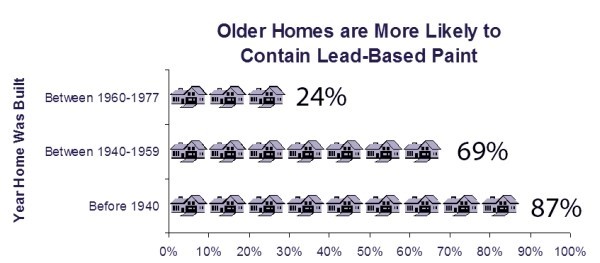In recognition of lead's well-known toxicity, New York City banned the use of lead-based paint in 1960, a full decade before the 1970 New York State ban and nearly two decades before the 1978 federal ban on lead-based paint. Nonetheless, most New York City buildings constructed before 1960 were originally finished with lead-based paints - as were many other buildings completed after the 1960 municipal ban but before the 1978 federal ban removed lead-based paint from the national market.

SOURCE: EPA, Protect Your Family from Exposures to Lead
Chipping, chalking, or peeling lead-based paint yields a toxic melange of lead-based paint particles and dust. This hazardous, highly mobile mixture travels rapidly from originating surfaces to other surfaces and rooms within contaminated homes, and even to other apartments or common areas within multifamily buildings. Even if it is covered up or partially removed, lead-based paint remains potentially hazardous until removed entirely using lead-safe work practices. Unfortunately, proper abatement is expensive and frequently foregone in favor of less expensive, temporary measures such as repainting. Covering up lead-based paint with newer, lead-free paint may work in the short term to slow down deterioration. However, as soon as the new layer of lead-free paint is damaged or begins to break down, continued erosion of the underlying layer is unavoidable.
Two factors - the age of a building and the income level of its occupants - are closely correlated with likelihood of exposure to deteriorating lead-based paint and lead-based paint dust. This correlation can be explained by the fact that (1) older buildings are more likely to contain lead-based paint and (2) landlords of low-income tenancies are often unable (or unwilling) to pay for inspection, abatement, and lead-safe repairs. Because so many NYCHA developments predate the lead paint ban and have not received lead abatement, NYCHA residents are at elevated risk of exposure to lead-based paint and lead-based paint dust hazards.
| Age of NYCHA developments: | |
| 70+ years | 14 developments |
| 60+ years | 60 developments |
| 50+ years | 75 developments |
| 40+ years | 89 developments |
| 30+ years | 52 developments |
SOURCE: NYCHA, 2017 Fact Sheet
NYCHA's track record of inadequate inspection and maintenance has placed thousands of young residents at risk of childhood lead poisoning. If your child has been exposed to lead-based paint or lead-based paint dust while living in public housing, please contact us today for a free case consultation. We can be reached at 1-800-483-0116 or through the form on this webpage.




Attorney Advertising: Prior results do not guarantee a similar future outcome.
Copyright © 2017 Levy Konigsberg LLP - Lead Poisoning Lawyers. All rights reserved.
Levy Konigsberg LLP, 800 Third Avenue, 11th Floor, New York, NY 10022.